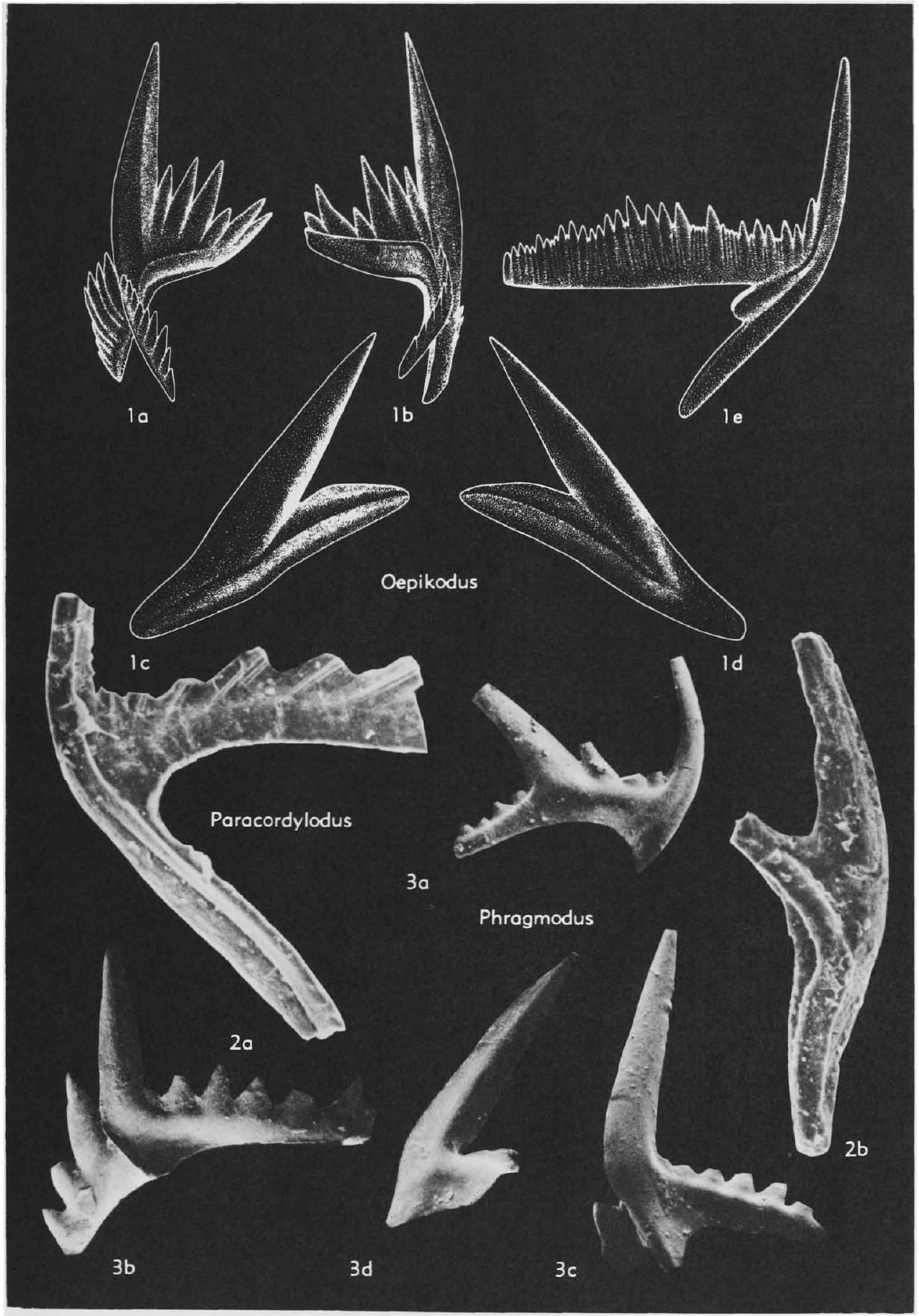Welcome to the Treatise on Invertebrate Paleontology!
Please enter a genera name to retrieve more information.

Oepikodus
Classification
Phylum:
Conodonta
Class:
Conodonta
Order:
Conodontophorida
Superfamily:
Prioniodontacea
Family:
Oepikodontidae
Formal Genus Name and Reference:
Oepikodus LINDSTRÖM, 1955, p. 570
Type Species:
O. smithensis, OD
Images
(Click to enlarge in a new window)
Fig. 75, 1. *O. smithensis, L.Ord. (Dalecarlicts Z.), Eu. (Sweden), la, b, pastinate element, lat. views, 1 c, d, genticulate element, lat. views, le, quadriramate element, lat. view, X50 (Bergström, n)
Synonyms
Geographic Distribution
Eu.-N.Am.-S.Am.-Australia-Asia (China)
Age Range
Beginning Stage in Treatise Usage:
L.Ord., ?M.Ord.
Beginning International Stage:
Tremadocian
Fraction Up In Beginning Stage:
0
Beginning Date:
486.85
Ending Stage in Treatise Usage:
L.Ord., ?M.Ord.
Ending International Stage:
Floian
Fraction Up In Ending Stage:
100
Ending Date:
471.26
Description
Diagnosis as for family = Apparatus basically trimembrate, consist!fig of lamellar pastinate and modified quadriramate, denticulate, ramiform elements and geniculate, adenticulate, coniform elements. Pastinate elements with well-developed, laterally compressed cusp, diverging downward from cusp one anterior and one posterior process and a lateral process, lateral process in some twisted posteriorly; all processes, or at least the posterior one, with denticles confluent along at least part of their length. Quadriramate elements with slender cusp, long adenticulate anterior process, long, laterally compressed multidenticulate posterior process, and rudimentary, adenticulate lateral processes. Basal cavity in both ramiform elements narrow but extending along entire length of processes. Geniculate element with rather long, reclined cusp and long base considerably extended anteriorly and posteriorly, base in some flaring slightly toward one side; basal cavity small, developed as subapical central pit, narrow and shallow grooves extending from pit along most of base. [Similar to Prioniodus, but distinguished by the presence of only two basic types of ramiform elements]
References
Lindström, Maurits, 1955, Conodonts from the lowermost Ordovician strata of south-central Sweden: Geol. Foeren. Stockholm Foerh., v. 76, h. 4 REFERENCES, , no. 21, p. 517-603, 6 text-fig., 10 pl.
Museum or Author Information
Classification
Phylum:
Conodonta
Class:
Conodonta
Order:
Conodontophorida
Superfamily:
Prioniodontacea
Family:
Oepikodontidae
Formal Genus Name and Reference:
Oepikodus LINDSTRÖM, 1955, p. 570
Type Species:
O. smithensis, OD
Images
(Click to enlarge in a new window)
Fig. 75, 1. *O. smithensis, L.Ord. (Dalecarlicts Z.), Eu. (Sweden), la, b, pastinate element, lat. views, 1 c, d, genticulate element, lat. views, le, quadriramate element, lat. view, X50 (Bergström, n)
Synonyms
Geographic Distribution
Eu.-N.Am.-S.Am.-Australia-Asia (China)
Age Range
Beginning Stage in Treatise Usage:
L.Ord., ?M.Ord.
Beginning International Stage:
Tremadocian
Fraction Up In Beginning Stage:
0
Beginning Date:
486.85
Ending Stage in Treatise Usage:
L.Ord., ?M.Ord.
Ending International Stage:
Floian
Fraction Up In Ending Stage:
100
Ending Date:
471.26
Description
Diagnosis as for family = Apparatus basically trimembrate, consist!fig of lamellar pastinate and modified quadriramate, denticulate, ramiform elements and geniculate, adenticulate, coniform elements. Pastinate elements with well-developed, laterally compressed cusp, diverging downward from cusp one anterior and one posterior process and a lateral process, lateral process in some twisted posteriorly; all processes, or at least the posterior one, with denticles confluent along at least part of their length. Quadriramate elements with slender cusp, long adenticulate anterior process, long, laterally compressed multidenticulate posterior process, and rudimentary, adenticulate lateral processes. Basal cavity in both ramiform elements narrow but extending along entire length of processes. Geniculate element with rather long, reclined cusp and long base considerably extended anteriorly and posteriorly, base in some flaring slightly toward one side; basal cavity small, developed as subapical central pit, narrow and shallow grooves extending from pit along most of base. [Similar to Prioniodus, but distinguished by the presence of only two basic types of ramiform elements]
References
Lindström, Maurits, 1955, Conodonts from the lowermost Ordovician strata of south-central Sweden: Geol. Foeren. Stockholm Foerh., v. 76, h. 4 REFERENCES, , no. 21, p. 517-603, 6 text-fig., 10 pl.
